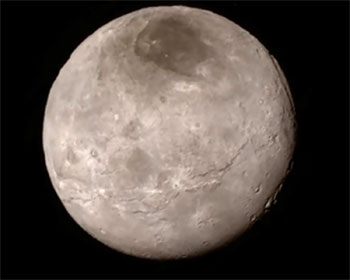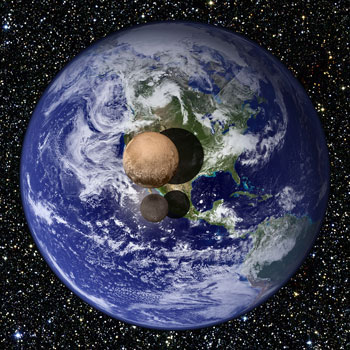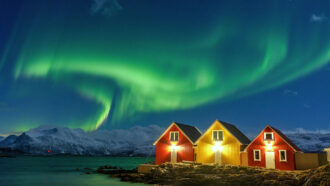Pluto hosts ice mountains, data suggest
The New Horizons probe turned up lots of surprises about our favorite dwarf planet and its moons
At 7:49 a.m. on July 14, the New Horizons spacecraft had its close-encounter with Pluto. The little spacecraft flew less than 12,500 kilometers (7,800 miles) from the dwarf planet. That’s a distance smaller than the diameter of the Earth. What the probe photographed along the way is not just elating scientists, it’s shocking them. But these are pleasant surprises.
For instance, the smallest of Pluto’s moons — Hydra — isn’t round. And its elongated shape appears composed largely of water ice. Charon, the biggest moon, has canyons. Some go down as much as 10 kilometers (around 6 miles). That would make these six times the depth of the lowest points in the Grand Canyon. And Pluto has mountains of water ice more than 3,500 meters (almost 11,500 feet) high, NASA now reports.
Let that sink in: water-ice mountains that could hold their own next to the Rockies. “Who would have supposed ice mountains?” asked Hal Weaver at a July 15 news conference. Weaver is a project scientist for the New Horizons mission to Pluto. He works at the Johns Hopkins University Applied Physics Laboratory in Laurel, Md.
“We’re not saying Pluto looks like this world or that world,” said Cathy Olkin. “There’s nothing like it,” explains this planetary scientist with the Southwest Research Institute in Boulder, Colo.
On July 15, mission scientists showed off three new pictures captured by the New Horizons spacecraft as it hurtled toward Pluto the day before. “We thought Charon would be an ancient terrain covered in craters,” said Olkin. But the new photo of this moon, she says, “just blew our socks off.”

But what elicited the most gasps from the gathered scientists, family members and journalists on hand to see the new images was a a close-up view of a 240-kilometer-wide swath of terrain on Pluto. It covers a region just south of a newfound “heart” shaped region. By the way, that heart area is now being called Tombaugh Regio in honor of Pluto’s discoverer. (Regio refers to a large place on some planet or moon that has a different color or reflectivity.)
Bill McKinnon of Washington University in St. Louis is a planetary scientist. When he first saw the close-up fly-by images, “I screamed,” he recalls. They were so surprising and scientifically informative.
Mountains draped across the landscape must be made of water ice, said mission leader Alan Stern. Like Olkin, he works for the Southwest Research Institute. There may be ices made from other materials on Pluto. But none of those would be strong enough to hold up a mountain. But at these temperatures, he explains, water ice is stiff enough to do it.
“We’re seeing the bedrock — or bed-ice — of Pluto,” Stern now concludes.
What the pictures don’t show
A big surprise: Not a single impact crater shows up among the mountains. That means the surface is very young, the scientists say — probably less than 100 million years old. “It might be active right now,” said Stern.
How these mountains formed remains a mystery.

However, Stern points out, “You don’t need tidal activity to power activity on icy worlds.”
So if not gravitational heating, where’s the energy coming from? When asked, the mission scientists just shrugged, signaling they don’t know.
A couple of ideas have been thrown out as possibilities. For instance, radioactive elements such as uranium may be buried deep in Pluto’s rocky core. The release of energy from the radioactive decay of such elements could provide some heating. Or, scientists noted, it’s possible there was once — or still is — a liquid layer lurking beneath Pluto’s surface. As the liquid freezes, it would release heat into the planet’s interior. That heat might be enough to drive geysers and icy volcanoes.
What’s clear to the scientists on the Pluto-exploration team is that even with just a handful of images on the ground, Pluto and Charon have not let anyone down. These are complex, dynamic worlds with many, many stories yet to tell.
“This is what we came for,” said Will Grundy of the Lowell Observatory in Flagstaff, Ariz.
No, Olkin quickly corrected him: “This exceeds what we came for.”
Power Words
(for more about Power Words, click here)
crater A large, bowl-shaped cavity in the ground or on the surface of a planet or the moon. They are typically caused by an explosion or the impact of a meteorite or other celestial body.
dwarf planet One of the solar system’s small celestial objects. Like a true planet, it orbits the sun. However, dwarf planets are too small to qualify as true planets. Prime examples of these objects: Pluto and Ceres.
dynamic (in geology or engineering) An adjective that signifies something is active, changing or moving.
geology The study of Earth’s physical structure and substance, its history and the processes that act on it. People who work in this field are known as geologists. Planetary geology is the science of studying the same things about other planets.
geyser A vent (opening) in Earth’s surface that intermittently sends up a tall spray of steam or hot water. The sometimes explosive discharge of water and steam is propelled by the geothermal heating of water below ground.
Grand Canyon A natural canyon in northwest Arizona that formed as the Colorado River cut through the rock here over the past 5 million to 6 million years. This is one of many canyons on the river, which drains water from seven states. The Grand Canyon is 446 kilometers (277 miles) long. Its depth varies. At its deepest point, the river is 1,829 vertical meters (6,000 feet) below the upper rim. From rim to rim, the canyon’s width also varies — from about 16 kilometers (10 miles) to 29 kilometers. Of this impressive national land formation, more than a million acres (4,931 square kilometers, to be exact) was turned into a U.S. national park in 1919.
gravity (adj. gravitational) The force that attracts anything with mass, or bulk, toward any other thing with mass. The more mass that something has, the greater its gravity.
moon The natural satellite of any planet.
Pluto A dwarf planet that is located in the Kuiper Belt, just beyond Neptune. Pluto is the tenth largest object orbiting the sun.
radioactive An adjective that describes unstable elements, such as certain forms (isotopes) of uranium and plutonium. Such elements are said to be unstable because their nucleus sheds energy that is carried away by photons and/or and often one or more subatomic particles. This emission of energy is by a process known as radioactive decay.
radioactive decay A process by which an element is converted into a lighter element through the shedding of subatomic particles (and energy).
regio Some large area on a planet or moon that is characterized by a different color or reflectivity.
solar system The eight major planets and their moons in orbit around the sun, together with smaller bodies in the form of dwarf planets, asteroids, meteoroids and comets.
tectonic Surface activity on a large rocky body (such as a planet or moon) as liquid rock flows up to the surface where it solidifies, then slowly drifts atop molten rock, carrying surface features with it.
terrain The land in a particular area and whatever covers it. The term might refer to anything from a smooth, flat and dry landscape to a mountainous region covered with boulders, bogs and forest cover.
tidal heating That’s the heating caused by the gravitational influence of the nearby planet.
tides (adj. tidal) The alternate rising and falling of the sea, usually twice in each lunar day at a particular place, due to the attraction of the moon and sun.
uranium The largest naturally occurring element known. It’s called element 92, which refers to the number of protons in its nucleus. One form (isotope) is radioactive, which means it decays into smaller particles. The other form is stable.
volcano A place on Earth’s crust that opens, allowing magma and gases to spew out from underground reservoirs of molten material. The magma rises through a system of pipes or channels, sometimes spending time in chambers where it bubbles with gas and undergoes chemical transformations. This plumbing system can become more complex over time. This can result in a change, over time, to the chemical composition of the lava as well. The surface around a volcano’s opening can grow into a mound or cone shape as successive eruptions send more lava onto the surface, where it cools into hard rock.







